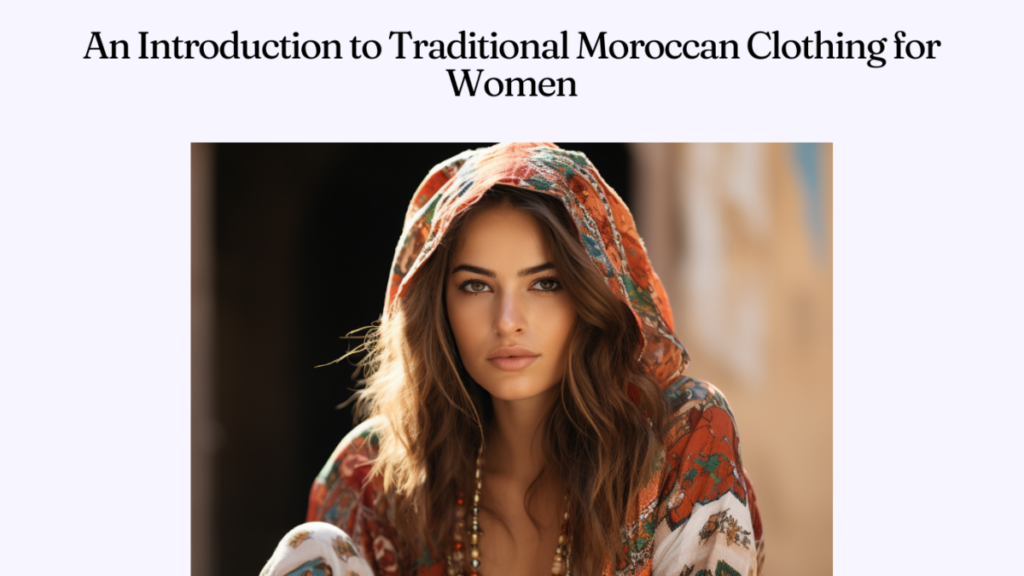This blog post explores the traditional clothing worn by women in Morocco. It looks at the history of the clothing, its unique style, and how it is worn today. It also provides information about the different fabrics used and how the clothing is decorated. Finally, it looks at the modern interpretation of traditional clothing and its global influence. This article will introduce the traditional Moroccan clothing for women, delving into its history, different types of garments, popular styles, and materials used.
What is Female Traditional Moroccan Clothing?
Morocco, a country rich in cultural heritage, boasts a vibrant and diverse fashion scene, with traditional clothing playing a significant role in expressing the cultural identity of its people. When it comes to women’s attire, traditional Moroccan clothing showcases an exquisite blend of intricate designs, vibrant colors, and exquisite craftsmanship. These garments not only reflect the country’s historical influences but also embody the elegance and beauty associated with Moroccan culture.
History of Traditional Moroccan Clothing
Traditional Moroccan clothing for women has a long and fascinating history rooted in the diverse cultural influences that have shaped the country over centuries. From the indigenous Amazigh tribes to the Arab and Andalusian influences, each era has contributed to the unique aesthetics and styles found in Moroccan attire.
Dating back centuries, Moroccan clothing has evolved through various dynasties, including the Almoravids, Almohads, and Marinids, each leaving its mark on the country’s fashion landscape. The clothing styles were influenced by the climate, social customs, and the wearer’s status within society.
Types of Traditional Moroccan Clothing
Moroccan traditional clothing for women encompasses a wide range of styles, each with its distinct characteristics and purposes. Here are some prominent types:
1. Djellaba: The djellaba is a loose-fitting, hooded robe made from various materials such as wool, cotton, or silk. It is worn by women throughout Morocco and is particularly popular in rural areas.
2. Kaftan: The kaftan is an elegant and luxurious garment worn for special occasions and celebrations. It is characterized by its floor-length design, wide sleeves, and intricate embellishments. Kaftans can be made from silk, satin, or brocade fabric and are often adorned with delicate embroidery, sequins, and beading.
3. Takchita: The takchita is a two-piece ensemble consisting of an underdress and a decorative overdress. It is typically worn for formal events, weddings, and festivals. The underdress is often plain and made from silk or satin, while the overdress is adorned with elaborate embroidery, beading, and metallic threadwork.
4. Haik: The haik is a traditional outer garment worn by women in rural areas, especially in the northern regions of Morocco. It is a large rectangular piece of fabric, typically made from wool, that is wrapped around the body to provide warmth and protection from the elements.
Design of Traditional Moroccan Clothing for Women
Traditional Moroccan clothing showcases a wide array of styles and materials, each influenced by regional customs and preferences. The diversity of Morocco’s geography and cultural heritage has contributed to the variety of clothing styles found across the country. Here are some popular styles and materials used in Moroccan clothing:
1. Bold Colors and Patterns: Traditional Moroccan clothing often features vibrant colors and intricate patterns, reflecting the lively spirit of Moroccan culture. Rich hues of red, blue, green, and gold are commonly seen, along with geometric and floral motifs.
2. Luxurious Fabrics: Moroccan clothing is known for its use of luxurious fabrics such as silk, satin, brocade, and velvet. These materials add a touch of opulence and elegance to the garments, making them perfect for special occasions and celebrations.
3. Embroidery and Embellishments: Embroidery is a significant aspect of Moroccan clothing, with intricate designs adorning many garments. Metallic threadwork, sequins, beads, and stones are used to create beautiful embellishments that enhance the overall aesthetic appeal of the clothing.
4. Handcrafted Jewelry: Traditional Moroccan attire is often paired with exquisite handcrafted jewelry, including silver necklaces, bracelets, and earrings. These accessories complement the clothing and add a
touch of sophistication and cultural significance.
Conclusion
In conclusion, traditional Moroccan clothing for women encompasses a rich tapestry of styles, materials, and cultural influences. From the elegant kaftans to the flowing djellabas, each garment tells a story of Morocco’s diverse heritage. The vibrant colors, intricate designs, and luxurious fabrics used in these garments make them not only a fashion statement but also a reflection of the country’s cultural identity.
FAQs
What are some popular colors used in traditional Moroccan clothing?
Traditional Moroccan clothing features a vibrant color palette, including shades of red, blue, green, and gold. These rich hues reflect the lively spirit of Moroccan culture and add visual appeal to the garments.
Where can one purchase traditional Moroccan clothing?
Traditional Moroccan clothing can be found in local markets, souks, and specialized boutiques across Morocco. These markets offer a wide range of options, allowing visitors to explore and purchase garments directly from local artisans. Online platforms also provide opportunities to purchase traditional Moroccan clothing.
Can traditional Moroccan clothing be customized or tailored?
Yes, traditional Moroccan clothing can be customized or tailored to suit individual preferences. Many artisans and designers offer custom-made garments, allowing for personalized sizing, design modifications, and choice of materials.
